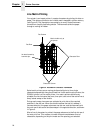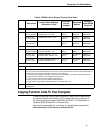
26
Chapter 1 Network Interface Card (NIC)
Network Interface Card (NIC)
Network Interface Card (NIC) allows you to attach printers on a local area
network (LAN) rather than attaching them directly to a host system. Following
simple configuration steps, these peripherals can be simultaneously shared
with users on the network whether you are using TCP/IP, NetBIOS over TCP/
IP, or IPX (Novell
).
NIC contains a network interface card to attach itself and the printer to the
network. This Ethernet™ 10/100Base-T interface connector is what allows the
printer to communicate with the network, and the interface itself has a number
of options, status indicators, and switches which are described in “NIC” on
page 27.
What Special Features Are Available?
NIC offers an extensive list of features including:
• built-in HTML forms for easy cross-platform configuration
• availability of printer manager software
• a detailed and easy-to-use command shell built in to the firmware
• multi-level configuration security through passwords, permission levels,
and access lists
• Wide Area Network (WAN) communication access
• numerous printer logging methods (e.g., automatic email) to record
printer errors and usage
• remote management through HTML forms, Telnet sessions, rsh/
rcmd/remsh
commands, SNMP, and pre-defined log methods
• extensive built-in troubleshooting tools
• built-in telnet and ping clients
• configurable memory usage by disabling protocols and destination
services
• multiple destinations/queues for versatile printer manipulation and distinct
print setups
• header and trailer strings to instruct printers on font, pitch, printing, etc.
• flexible naming conventions
• automatic network connection and frame type sensing
• simultaneous printing across all I/O ports and all supported protocols
• multiple network protocol support


















